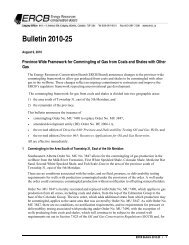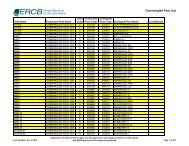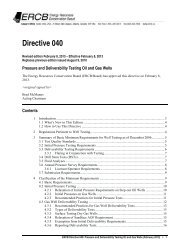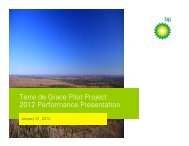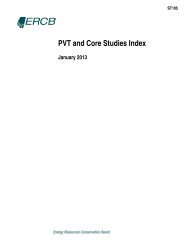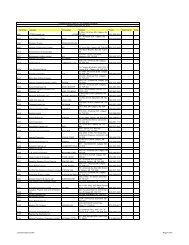Directive 065 - Energy Resources Conservation Board
Directive 065 - Energy Resources Conservation Board
Directive 065 - Energy Resources Conservation Board
Create successful ePaper yourself
Turn your PDF publications into a flip-book with our unique Google optimized e-Paper software.
<strong>Resources</strong> Applications Notification Guidelines<br />
When to Notify<br />
Whom to Notify<br />
Effective notification and consultation programs are critical not only to ensure an efficient<br />
regulatory process but to promote long-term relationships. The ERCB prefers, and requires<br />
for some resource application types, that both industry and public (where required)<br />
notification be completed prior to the filing of the applications.<br />
Minimum notification requirements for specific types of resources applications are included<br />
in Tables 1 and 2 of this section. In addition to meeting the minimum notification<br />
requirements, the ERCB expects you to review your situation and consider whether there are<br />
potentially directly and adversely affected parties outside the minimum notification areas and,<br />
if so, also provide notification to these parties.<br />
In some cases, the ERCB requires notification for informational purposes only. This type of<br />
notification provides information regarding a potential development to support, promote, and<br />
encourage early and ongoing discussions between persons.<br />
How to Conduct Notification<br />
Notification is the first step in providing information and is usually conducted through<br />
written correspondence, while consultation must occur face to face or by telephone. Early,<br />
proactive notification programs are more likely to result in positive relationships.<br />
To this end, the ERCB believes that newspaper advertisement does not meet these objectives<br />
and should only be used to supplement direct notification in extenuating circumstances. If<br />
you know there will be contentious or complex issues respecting a resources application,<br />
personal consultation may be preferable as a first step rather than notification. Notification<br />
programs that do not provide for direct notice to a person should be discussed with the ERCB<br />
prior to conducting the program.<br />
You should provide notification of a proposed application by means of a letter that includes<br />
adequate information to allow persons to understand the proposed development and the<br />
impact it may have on them. Formats for notification letters are included in Appendix B (for<br />
well spacing notification templates, see Appendix J). Notification must take into<br />
consideration whether the person being notified is an oil and gas company, a Freehold<br />
mineral owner, or a landowner or occupant. You must include applicant contact information<br />
in the notification letter, as well as directions about what action persons should take if there is<br />
a concern. In all cases, persons should be directed to submit any concerns directly to the<br />
applicant, not to the ERCB.<br />
In providing notification, you must take possible delays in delivery of the notification<br />
package into consideration. Each person notified must be given a minimum of 15 working<br />
days from the date the letter is mailed to respond. A signed letter of consent or nonobjection<br />
to the proposal is not required. However, it should be clear in the letter that if the person<br />
notified does not respond to the notification package, filing (if not filed) and processing of<br />
the application with the ERCB will proceed without further contact.<br />
ERCB <strong>Directive</strong> <strong>065</strong>: <strong>Resources</strong> Applications / Notification Guidelines (March 2012) • 17



